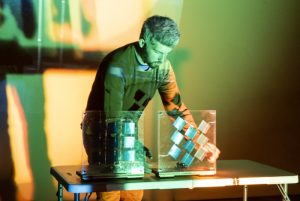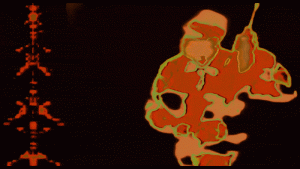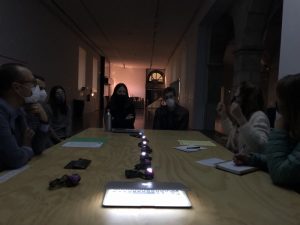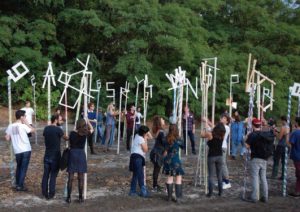Material Beliefs is a group of designers based in London. They might create pieces of furniture and accessories but they are not your usual tables and cups. The result of a close collaboration with scientists and engineers, social scientists but also members of the public, their projects take emerging biomedical and cybernetic technology out of labs and into public space. The members of Material Beliefs use design as a tool for public engagement, a mean to stimulate discussion about the value and impact of new technologies which blur the boundaries between our bodies and materials.
Each of the prototypes they develop is the starting point of a fruitful and much needed debate in public space about the relationship between science and society.
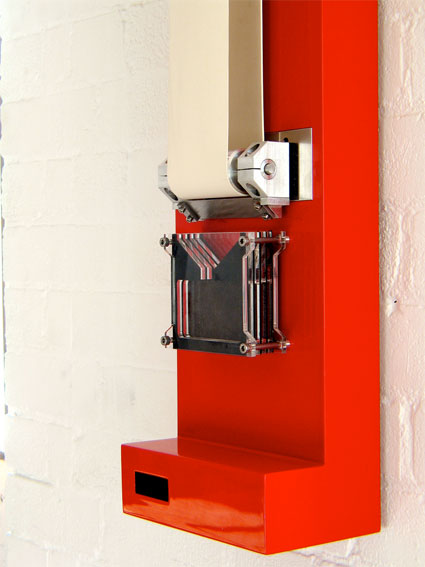 Fly-paper robotic clock © Auger-Loizeau 2008
Fly-paper robotic clock © Auger-Loizeau 2008
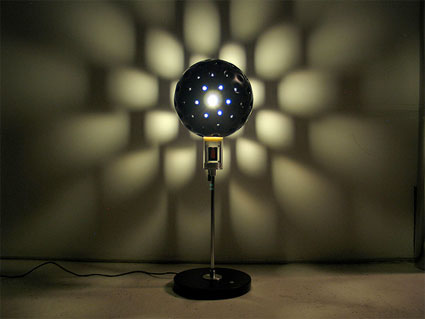 Lampshade robot © Auger-Loizeau 2008
Lampshade robot © Auger-Loizeau 2008
Their prototypes are questionable and puzzling. They include a series of extremely cruel and useful Carnivorous Domestic Entertainment Robots (think moth-eating lamps and a robotic coffee table that doubles as a mouse trap) and pastel pink or baby blue Vital Signs monitors (a product of the child surveillance industry, they enable data about the body to be communicated across a mobile phone network.) You can encounter them in venues as different as the Dana Centre in London and LABoral Centro de Arte y Creación Industrial in Gijon, Spain.
At the heart of Material Beliefs are Andy Robinson, Elio Caccavale, Tobie Kerridge, Jimmy Loizeau (with James Auger) and Susana Soares, supported by collaborations with Aleksandar Zivanovic, Julian Vincent, Kevin Warwick, Slawomir Nasuto, Ben Whalley, Mark Hammond, Julia Downes, Dimitris Xyda, David Muth, Tony Cass, Olive Murphy, Nick Oliver, Dianne Ford, Luisa Wakeling, Julie Daniels and Anna Harris.
My victim for this interview is designer Tobie Kerridge whom i wanted to talk with ever since i read about about a project he conceived than actually prototyped together with scientist Ian Thompson and designer Nikki Stott: Biojewellery. The project catapults traditional engagement and wedding rings into the world of tissue engineering and biotechnology research by using bone tissue cultured from human cells in order to create bespoke jewellery.
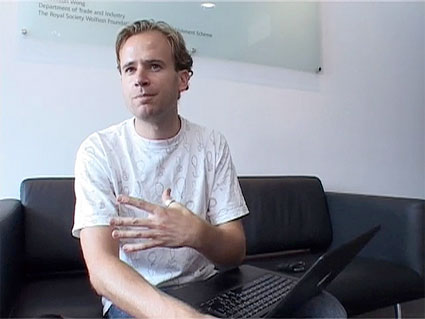 Tobie at the Institute of Biomedical Engineering, Imperial College
Tobie at the Institute of Biomedical Engineering, Imperial College
I must admit that i almost regretted to have asked you this interview. While preparing it, i had a long look through the website of Material Beliefs and found it so complete and so well documented that i felt that there was nothing left for me to ask you. I then had the idea of doing a ‘designboom style’ interview where the designer is asked all sorts of apparently frivolous questions. So now the idea has become irresistible and here’s a question i stole from designboom: I assume you notice how women dress. Do you have any preferences?
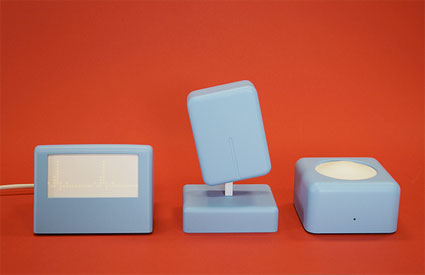 Vital Signs monitors © Tobie Kerridge 2008
Vital Signs monitors © Tobie Kerridge 2008
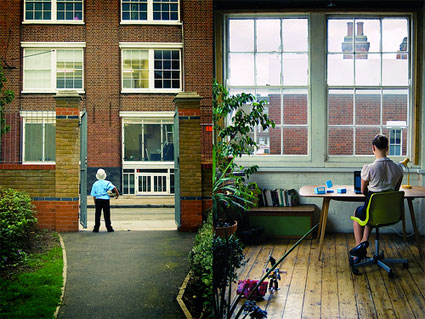 Vital Signs scenario © Tobie Kerridge 2008
Vital Signs scenario © Tobie Kerridge 2008
Then I’m going to be cheeky and and steal someone’s answer, Inga Sempé’s was nice – “no“.
I like the name of the project, Material Beliefs, a lot. Where does it come from and which kind of ideas do you want it to convey?
Ah, this is a long story, and it also shows a lack of imagination under pressure. I was writing the funding proposal for Material Beliefs with Savita Custead, and we had to get the thing submitted. Being a bit stuck for names, the project title came about by co-joining the titles of two beloved projects.
One is Materials Library, run by Mark Miodownik, Zoe Laughlin and Martin Conreen. They operate an archive of materials, and take these artefacts into public spaces by staging performative events. They convened a series at the Tate, and then followed on with events at the Wellcome Collection themed around Flesh and one coming up soon will focus on Hair. Their obsessions create new communities that play across disciplines.
The other was a proposal for funding to the ECRC by Robert Doubleday, Mark Welland, James Wilsdon and Brian Wynne called “Material Imaginations”. Their proposal followed on from a project I first read about in See Through Science, a report by DEMOS. Doubleday set up an ethnographic project in Welland’s Nanotechnology lab, the aim being to work with scientists to imagine the social outcomes of their nanotechnology research. He said “My role is to help imagine what the social dimensions might be, even though the eventual applications of the science aren’t yet clear”. This made me think about the role of design as a set of speculative tools for working with science and engineering.
I was a student of Durrell Bishop, Tony Dunne, Bill Gaver, Fiona Raby, and other fine tutors at what’s now the Design Interactions course at the Royal College of Art. In this context, my practice emerged through an interrogation of design methods and aims. Material Beliefs is an attempt to make design’s association with science and technology more embedded. It takes influence from Doubleday’s – and previously Bruno Latour’s and Steve Woolgars – encampment in labs. The difference is that the role of that occupation is more than analytical, it attempts to synthesise outcomes – what happens when speculative attitudes to science and technology get located at the site of laboratory research? Well not much sometimes, but other times it works out and you get a fascinating and messy shared practice. Designers and Scientists/Engineers also have to work harder to understand each others roles and offer respect and support – it’s difficult and rewarding.
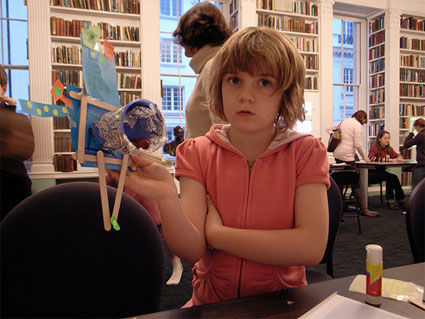 Building fly-eating robots at the Royal Institution of Great Britain
Building fly-eating robots at the Royal Institution of Great Britain
The other aspect is that these collaborations take place in public as much as possible. Taking inspiration from Miodownik, Laughlin and Conreen, it’s about doing the work in front of and with audiences. These are not only the audiences you might find at art or design exhibitions. Sometimes the model of public engagement is not top-down, but about getting people into labs and enabling them to do new stuff – making enquiries, building their own prototypes, asking researchers about the ethics of technology, finding out how funding is awarded.
Here design becomes a tool for translating academic knowledge into resources for independent enquiry, and a way of enabling others to access technology. This can be tricky as you have to sneak people into labs, under the radar of public relations departments who might not see the value of access for groups that wont promote the research in a straightforward way. This is not a criticism, it just that some institutions are not yet set up for challenging forms of public engagement. This situation I think is aggravated by an institutional anxiety about campaigning groups, but that is another story.
Finally, when I first Googled “Material Beliefs” it was all about religious practices, and it seemed appropriate, seeing as we were going to be doing so much preaching.
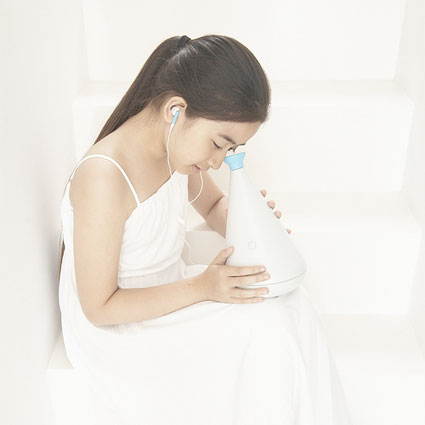 Neuroscope Prototype © Elio Caccavale 2008
Neuroscope Prototype © Elio Caccavale 2008
Material Beliefs looks like a unique structure. I suspect that many artists and designers would dream of engaging with emerging biomedical and cybernetic technology in close cooperation with engineers and social scientists. Which kind of advice would you give to artists or designers who might want to set up a design lab like yours? How did you manage to get the ear (and funding) of the Engineering and Physical Sciences Research Council in England?
It’s a good time to extend design practices that ask questions about our relationship with technology and science. In the UK at least, there is an ongoing discussion about how public engagement of science should be done. This is a discussion at a policy level, about democratising access to the research that will have its outcomes in the products and services we use. So while public engagement of science used to be about persuading the public that science produced a benefit, or where it was a strategy for encouraging a new generation of scientists, engineers and mathematicians to keep the nation competitive, it is now also about looking for new ways to involve different groups of people in science. These discussions then filter down into decisions about how funding is awarded. I think Material Beliefs probably benefited from new attitudes about what public engagement of science is allowed to be.
We set out to say that design lets non-specialists respond to science in creative ways, to make their own things out of their curiosities with bioengineering, and to have an active role within the production of research, or at least to play a role in the discussion of what unfinished research might come to mean. Rather than be told that this or that technology is not really risky, or at best being invited into a conversation that decides if a technology is risky, publics can actually have some kind of active role in how technology encountered. That’s what design can do, it encourages an active orientation towards materials and processes, it provides a reason to try to do something, rather than sit back passively, then point your finger out of anxiety, for example over the potential effects of biotechnological products and services that suddenly appear on the market – “Where did that come from? Frankenfoods messing up my body, I am even angrier now!”. The fact is that science is complex, it is enacted through a relationship between peers and rivals, institutions, markets, funders, politicians, ethics committees. Rather than ignore that, or treat science as monolithic entity, why not try to situate a practice productively somewhere amongst this fascinating network? Material Beliefs is only starting to think about this extended role for design, others have been doing it for some time, and I’m thinking of Natalie Jeremijenko‘s practice, Symbiotica‘s lab in Perth, and the thinking that has informed the Design Interactions course.
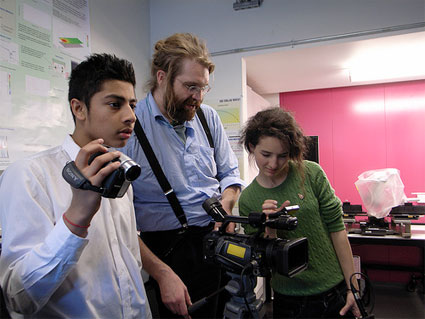 Group from the Roundhouse interviewing researchers about cyborgs
Group from the Roundhouse interviewing researchers about cyborgs
More generally, how do scientists react to your interests and works? Are they immediately ready to cooperate? Do you have to painfully win them over? How easy is the dialogue with people who seem to have a radically different background?
One thing learnt from this project is to take the invitations very wide initially, and to rapidly make sense of who might want to collaborate. Material Beliefs is lead by the designers, James Auger, Elio Caccavale, Jimmy Loizeau, Susana Soares and myself, and I must say that all of us broke our backs pursuing eminent, exciting but ultimately uninterested scientists and engineers. If people want to do stuff, then run with them. The hardest aspect was articulating our approach, and making it clear what was expected and what we would be doing. Academics are busy, whatever their discipline, and there are not many academics you could expect to spend time doing activities that are outside of there specialism. That is asking a lot.
Luckily, there is some pressure on science and engineering to do public engagement. Being able to show you have done this helps with funding. This was something we could appeal to. I don’t think this is being tricksy, it’s just a matter of finding a recognisable space in which to hold the stuff you want to do, that makes sense for everyone, even if it is for slightly different reasons. You all need to take risks, the designer needs to be elastic with their focus as a practitioner, and the engineer scientists need to take into account alternative descriptions of their research objects. It’s not easy to make sense of a question about the ethics of a technology that you have been developing intensively for two years.
We are, or I hope were, quite naive in the way we approached science, which of course has a different culture to design. I have a particularly painful memory of filming an interview with a researcher, and not making it clear that the interview was to be put online. He was very angry when | sent him a link for approval, particularly as the first clip was me setting up and dropping the camera, and kind of laughing awkwardly. I thought the clip was charming. He thought I was taking the piss, and sent some quite angry emails. Have a look at some of the interviews that did get approved. This was a way for us to read around the research, to get it from the researchers mouths. Their descriptions are imbued with their excitement, and taken down a notch so we can understand. Perfect. Imaging having to orientate your practice to biotechnology through academic papers, or newspapers – the extremes of possible discourses – that leave you respectively bewildered or sour.
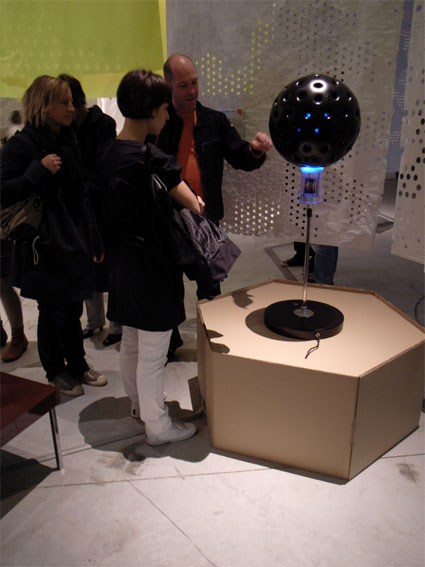 Carnivorous Domestic Entertainment Robots at LABoral
Carnivorous Domestic Entertainment Robots at LABoral
“Material Beliefs blur the boundaries between material culture and bioengineering research, designing speculative products that embody emerging technologies.” How does one design a speculative product? And how can a product be “speculative”? How do you avoid the label “Art”?
You design something that you don’t mean to manufacture. We all used design methods and processes, and built prototypes, but the emphasis was with the interaction between the prototypes and statements about social life, rather than the prototypes and business. If you want to make a product, you will spend more time specifying materials because unit cost is important, or you will be looking for intellectual property opportunities, and talking to distributors. That’s fine, but you can’t also then ask public questions about the role of technology. You can try, but I’m sure you will be very tired, and loose some friends and alienate your family.
The question about art is important. I think it would have initially made our lives easier to say we were doing a sci-art, both in terms of forming collaborations and finding a descriptive label for the outcomes. The problem with using established relationships is that you also have to deal with a set of associated problems, and limitations. I’m not talking about participating in art exhibitions, or discussing the work within an art theory discourse, this is more about assumptions various people might have about doing a sci-art project. While initially frustrating to say “this is neither art, nor design for innovation” it was liberating to develop our own processes and methods for working with scientists, engineers and publics.
One place that seems to do sci-art well is the residency programme at Peals, Elio did something there. What often seems to happen, is that there is an assumption that art will benefit from science, and science will benefit from art. That’s crap, it’s like a small dinner party for two couples, both delighted at the company of one another. What Peals does is address the way the collaboration can be enacted through a much wider network of people.
So it’s not about a problem with the label of art, just whose label that is, and what they are trying to do with it. It’s worth mentioning SymbioticA again here, who have managed to set up a lab that invites and educates arts practitioners. This is proper, it has been developed slowly and carefully, to the point where it is respected and supported for what it does, by people from many different disciplines. Of note in the UK also is Arts Catalyst.
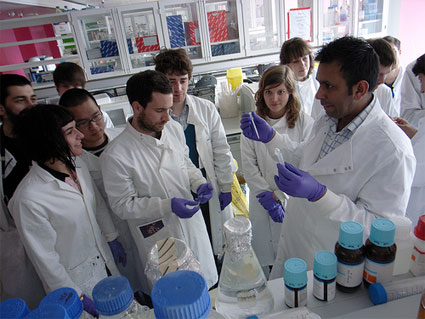 Design Interaction students isolating their DNA at the Institute of Biomedical Engineering
Design Interaction students isolating their DNA at the Institute of Biomedical Engineering
Do you have pictures of MB working studio? Does it look and function more like a lab or your usual design studio?
Material Beliefs is scattered about the place. There is the Interaction Research Studio and design workshop at Goldsmiths, RapidForm and Design Interactions at the RCA, the Institute of Biomedical Engineering at Imperial College, Cybernetics and Pharmacy at Reading University, and the Institute of Ophthalmology at University Collage London. Project activities are based at the most appropriate site, and in some cases need to be run across multiple sites at the same time. The Neuroscope project is noteworthy here, with Julia Downes and Mark Hammond working with cell cultures and server side software, Elio Caccavale desiging CAD prototypes and David Muth writing a client application.
Equally important are the venues where members of the collaborations curate public events. These have included The Dana Centre, the V&A, MoMA, the Design Museum in London, The Royal Institution of Great Britain, the National Theatre, The Stephen Lawrence Centre, LABoral and Selfridges. There’s a full list here. These forays into public spaces have acted as a cross between work in progress shows, design crits and think-tanks.
There have also been some smaller scale activities that are really messy, and which have transgressed divisions between labs and publics. There was an event at the Institute of Biomedical Engineering (IBE) called Mind the Loop, that had no clear design outcome, it was just too interesting to neglect. The silicon beta cell is designed to behave like an artificial pancreas, sensing blood sugar levels in the body and applying this biometric data to an algorithm which controls an insulin pump to regulate the blood sugar levels. That’s the loop, It’s a biological system rendered in silicon. Then around this technology you have different people, including the engineer who is making it work, the person who might use the silicon beta cell, and the doctor who negotiates and implements use. Mind the loop was a conversation between these three people, filmed by Steve Jackman.
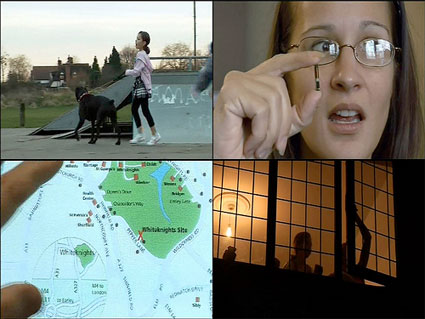 Stills from Cotton Wool Kids, Cutting Edge for Channel 4 UK TV
Stills from Cotton Wool Kids, Cutting Edge for Channel 4 UK TV
Material Beliefs kicked off with a statement about biological and silicon hybrids, looking perhaps for the collaborations to establish a contemporary description of cyborg. The conversation about the silicon beta cell was striking because it showed the model of this hybrid was more extensive, it was more than one person, the technology is not stable, both in terms of its function and meaning and it took on the values of different communities. At the same time, as the collaboration at IBE was being discussed at public events I became aware of lots of discussion about the relationship between biomedical engineering and monitoring, trust and risk. I built Vital Signs to locate this discussion in a product that monitors a child’s biometrics. In the UK there’s a debate about childhood and risk, Cutting Edges Cotton Wool Kids and the RSA’s recent report are examples. The Vital Signs prototypes are not critical of biomedical research, but designed to ask some questions about how technologies reproduce and materialise social relations.
Sorry, that’s drifted away from the question a bit! I hope it gives an example of how the collaborations operate across different sites.
I am very intrigued by the role of Andy Robinson. He is the project manager of MB. How does one manage the speculative? What does his function involve?
I’ll ask Andy.
Andy Robinson: My approach to managing the specualtive is to combine the essentials of any project management role, aims and objectives, timescales and milestone etc etc. with a very clear understanding of the particularities of the participants and their ways of working. It is a conversation between participant and the aims set up for the project, where review and redirection are always possible within an agreed, often revised, playing field. The funder is crucial in this in setting up the opportunity for such a project in the first place. This is where the important tone is set, and i try to manage the conversion between participants and this tone. My function therefore is to have an overview, be neutral amongst agendas, but support the initial voice of the projects aims to engage with the participants skills and motivations. Ultimately it is to support creativity to flourish, risks to be taken, the unexpected to be embraced, and speculation to thrive.
I had a huge row with my boyfriend a few years ago. And you’re the one to blame. He was totally into doing one of your biojewellery rings and thought i didn’t love him enough to sacrifice a bit of wisdom tooth to make one. Where are the rings now? Are you still working on the project? What separates them from mass commercialization? The technology is too expensive? People find the idea hard to stomach?
Ha, sorry to hear about your row! At least you didn’t end up with a nasty mouth infection like one of the participants. She was very nice about it, despite the discomfort and having to go on a course of antibiotics. I think the project managed to pay for parking fines she incurred while having the operation, which is some small compensation for a rather frustrating series of events for her.
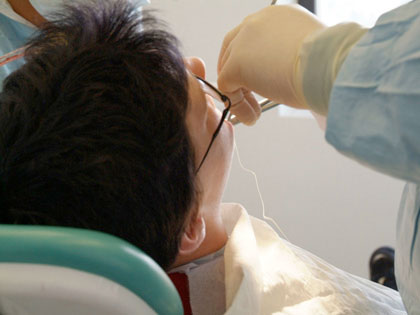
Though it was not the tooth that provided the sample for the rings. Painful wisdom teeth merely provided a medical reason to have a bit of jaw bone removed, “while we’re in there, lets just take a little chip of bone”. I’m trivialising something that Ian Thompson did a great deal of work on – an application to a medical ethics committee for permission to run and experiment on the in vitro interaction of osteoblasts with ceramic scaffolds. So growing the rings for the couples also contributed to research about how to culture bone tissue into fairly large volumes.
The real rings are with the couples, and there are various models that tour around. Nikki Stott is setting up an exhibition in Spain shortly, and there have been quite a few shows this year. So it’s archived and still active.
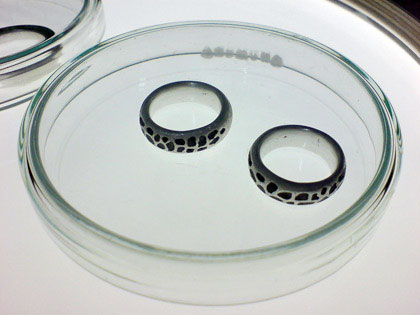 Any upcoming projects you could share with us? Either personal or from Material Beliefs?
Any upcoming projects you could share with us? Either personal or from Material Beliefs?
Carnivorous Domestic Entertainment Robots and Vital Signs are part of the Touch Me festival in Zagreb, so Jimmy Loizeau and I will take some prototypes for exhibition, and I think present Material Beliefs as part of the symposium. The festival theme “arises from the need for artistic and cultural analysis of contemporary forms of violence and systems of control”. This is something of a departure from the other weekend, when I was sitting with four year olds in the Royal Institution of Great Britain drawing fly eating robots with felt tips.
I’m then really looking forward to 2009 and getting into my phd, and your questions have given me some things to think about, so thanks for that!
Thanks Tobie!
All images courtesy Material Beliefs.

